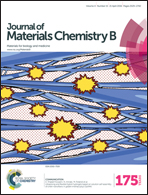Novel amino acid based nanogel conjugated suture for antibacterial application
Abstract
In this study, a promising preparation strategy for antibacterial silk sutures with an L-lysine based nanogel grafting is reported. The triclosan-loaded nanogels (NGTLs) were fabricated by the convenient enzymatic degradation of macrogels, namely, triclosan-loaded macrogel, degrading into NGTLs triggered by the trypsin. Nanogels, about 60 nm and 90 nm in diameter, were obtained after 7 days of biodegradation in the enzyme solution. Triclosan maintained a sustained release period over 260 hours in trypsin solution with the concentration of 0.1 mg mL−1. Triclosan-loaded nanogel grafted silk sutures (TLNGSs) were characterized by an antibacterial activity assessment. Our results showed that TLNGS had long-term efficacy against pathogens such as S. aureus and E. coli. In particular, these TLNGSs had a relative decreased stable size of inhibition zones on agar plates in the first four days. The antibacterial activity could be sufficient evidence of the prevention of potential early wound infections. The mechanical strength tests indicated negligible influence on TLNGSs compared to commercial ones. The novel antibacterial silk sutures showed acceptable in vitro cytotoxicity according to ISO 10993-5. This novel biocompatible and biodegradable nanogel grafting to silk sutures provides an effective and universal approach for the treatment of bacterial infections.


 Please wait while we load your content...
Please wait while we load your content...